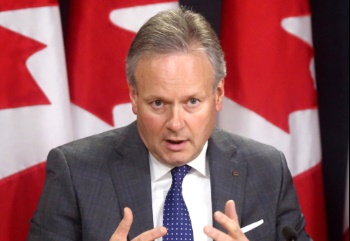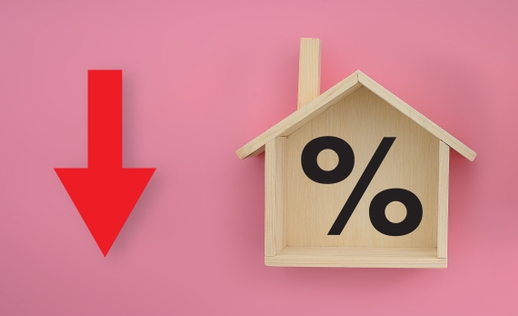Amid a global growth scare, the BoC has slashed Canada’s most-watched rate for the first time in almost five years.
“…The COVID-19 virus is a material negative shock to the Canadian and global outlooks,” the Bank said in its statement today.
Despite how concerned the bank is about fuelling more debt, it chopped its overnight target by 50 bps to 1.25%. The move follows the U.S. Fed’s emergency 50 bps rate cut yesterday.
The question now is, will the Big 6 banks be charitable and pass through the easing to prime rate? Millions of variable-rate and HELOC borrowers are hanging on the outcome.
Here’s a quick summary of this morning’s Bank of Canada rate decision:
- Rate Announcement: 50-bps cut
- Overnight rate: Now 1.25%
- Prime Rate: Currently 3.95%; pending a change (see Prime Rate)
- Market Rate Forecast: Two more rate cuts in 2020
- BoC’s Headline Quote: “As the situation evolves, Governing Council stands ready to adjust monetary policy further if required to support economic growth and keep inflation on target.”
- BoC on the Economy: “…The COVID-19 virus is a material negative shock to the Canadian and global outlooks…”
- BoC’s Full Statement: Click here
- Next Rate Meeting: April 15, 2020
The Spy’s Take

“It is likely that as the virus spreads, business and consumer confidence will deteriorate,” the BoC said today. Falling consumer and business spending could send Canada closer to recession. These ominous headlines and coordinated global rate cuts, including the “emergency cut” we saw from the Fed, are almost adding to market panic as much as they’re calming it. Worry over why officials are making extreme cuts could actually fuel the slowdown that central bankers are trying to avert.
It’s not surprising then that bond traders again rushed into bonds for safety today. That drove down Canada’s 5-year yield by 7 bps at the time this is being written.
By the end of the year, Canada could end up just 0.75% from zero on its policy rate—assuming the bond market projections prove correct. As for the U.S., it’s now just four 25-bps cuts away from 0% on the lower bound of its key rate. Once recession hits, it will likely get to zero, possibly below zero like Japan and Switzerland. It’s a matter of when. And imagine what that will do to Canadian rates, which take their cues from America’s bond market.
How Much Will Banks Cut Prime Rate?
The appeal of floating-rate mortgages will depend partly on how major banks react to the BoC’s move.
They’ve shown in 2008 and 2015 that they’re fully willing to keep some BoC easing for themselves. And in 2016 we even saw TD arbitrarily hike its mortgage prime by 15 bps. That reality takes some lustre off of floating rates.
Opinion poll:
What is the probability that Canada’s big banks pass along the next Bank of Canada rate cut in full when lowering their prime rate?
— RateSpy.com ?? (@RateSpy) July 22, 2019
For a sense of rates further out, keep an eye on oil prices, given how much Canada relies on resource prices to drive business investment. Some estimate that oil demand could plunge more this quarter than at any time on record. That factored into the BoC’s thinking today.
And watch two other rates while you’re at it: Canada’s unemployment rate and the coronavirus growth rate. Acceleration in either would be bearish for mortgage rates over the medium term.
If bond yields keep diving from here, it also raises a question of how much “risk premium” banks will build into mortgage rates. Banks always protect themselves when unemployment spikes and credit risk builds. And that often coincides with surging funding costs, which banks also pass through to consumers. In other words, when liquidity for banks is constrained, it raises their mortgage costs and borrowers see smaller discounts.
If that happens anywhere close to like it did in 2008, it could leave rates higher than normal, relative to bond yields, for potentially 6-12 months (our best guess).
For now, the probability is low that we’ll see liquidity dry up as much as the 2008 experience. The BoC tried to assure the market today by saying, “…The Bank will continue to ensure that the Canadian financial system has sufficient liquidity.” But with an unpredictable pandemic (or near-pandemic if you prefer), almost anything is possible.
The Way to Play It

Mortgage pros all know that short-term and floating rates have historically outperformed. In a down-trending rate environment with an inverted yield curve and growing economic risk, that’s even more true.
The problem is, today’s variable rates are relatively high compared with fixed. And banks could disappoint us again by withholding some of the BoC’s easing.
That makes shorter-term fixed rates all the more appealing. For one thing, they’re cheaper than variables upfront. For another, they give you a chance to reset your rate lower if rates drop—as the market expects. If you can time things right, they also reduce your odds of:
- paying a penalty if you choose to break the mortgage early
- paying inflated rates at your existing lender if you choose to refinance before five years.
Today you can find sizzling deals on default-insured (“high-ratio”) mortgages, like HSBC’s 1.99% 3-year fixed. For uninsured mortgages, 2.59% or less can be found on a 2-year fixed.
By comparison, the best widely available uninsured 5-year fixed rates are roughly 2.59%. That’s 30 bps lower than an equivalent variable rate, which doesn’t happen very often.
Today’s rate cut could potentially narrow that fixed-variable gap, but fixed-5s should still outsell variables for now. That’s despite expectations for further rate cuts.
If you do lock in for five years, don’t pay more than 2.59% (assuming you’re well qualified). And do yourself a favour by choosing a provider with a fair penalty policy. That way, you’re not as bound to your lender for five long years; i.e., you’ll pay less to refinance if you want to take advantage of cheaper rates or pull out equity down the road.

 log in
log in

9 Comments
The last round of rate increases saw all 5 hikes fully passed on to the consumer, so it would really put variable rate holders at a disadvantage if the next 5 rate cuts were not equally given back. The current BOC vs Prime rate spread 2.2% (was 2% prior to 2015) In the US their spread is 3% so it wouldn’t surprise me if banks continue to take more off the top with future rate cuts.
Glad to see RBC passing on the whole cut.
Hopefully everyone else will follow suit (we are watching you TD)
Why does US Bank prime run so much higher than Canadian Bank prime?
Quick question will this cut increase purchasing power in regards to the stress test?
It should be illegal for the banks to not pass through the rate cuts to the prime rate.
When rates rise they pass through the full increase 100% of the time. But when rates get cut they ‘may’ pass through the discount.
Most interestingly all the banks act together on the prime rate. Price fixing anyone?
Here’s hoping ALL lenders pass on the full .50
Waiting for an announcement from RMG….
Just for info. and thanks to TD Bank, my variable rate has been cut down full .50 by TD Bank.
ICICI Bank has also cut the full 50bps.
The cut is effective today, so one day later is not too bad for a smaller bank.
As of March 17th…TD bank has still not passed the 2nd .50% cut on varible home equity lines of credit